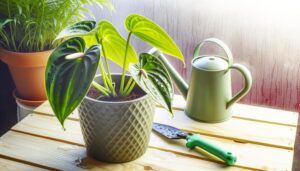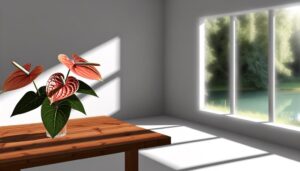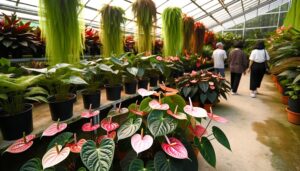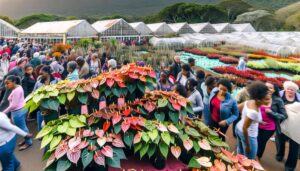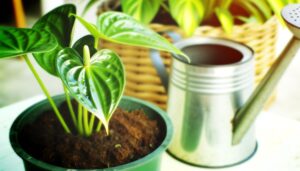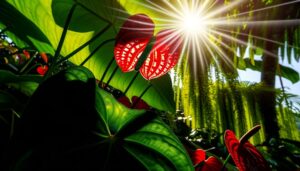Growing Anthurium Plant in Lava Rock in Three Steps
To cultivate an Anthurium plant in lava rock, start by selecting a healthy, epiphytic variety like Anthurium andraeanum. Next, choose high-quality lava rock with medium-sized, porous pieces for optimal aeration and drainage.
Rinse the lava rock thoroughly and layer it 2-3 inches deep in a container with multiple drainage holes. Position the Anthurium's roots on the rock and add more lava rock around them, leaving space at the top.
Guarantee your plant receives bright, indirect light and consistent moisture, using distilled or rainwater to avoid mineral buildup. There's more to mastering Anthurium care and achieving thriving growth.
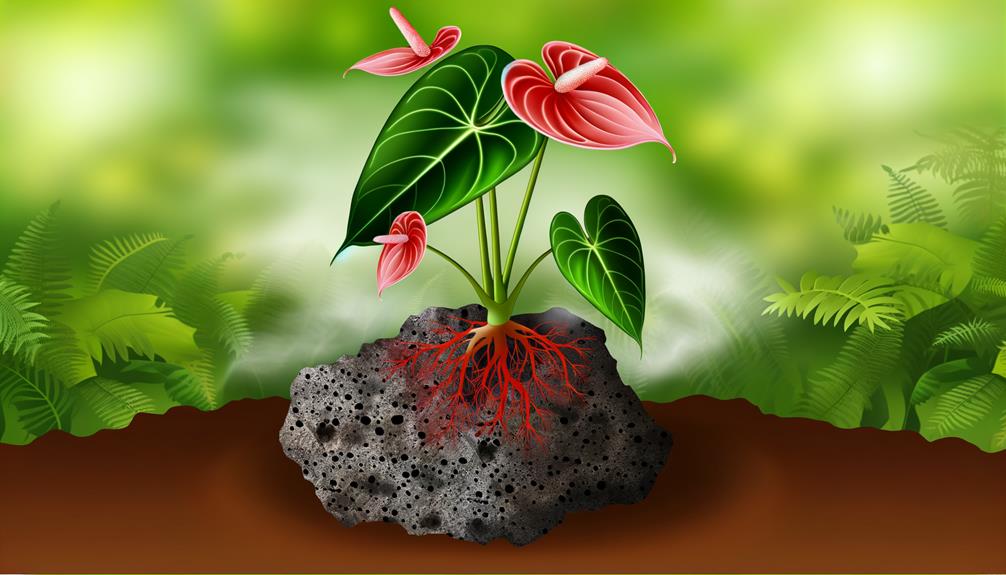
Key Takeaways
- Rinse lava rock thoroughly and place a 2-3 inch deep layer in a container with multiple drainage holes.
- Position Anthurium roots over the lava rock and add more rock around the roots, leaving space from the top.
- Maintain bright, indirect light, consistent temperatures (60-85°F), and humidity levels at 70-80%.
- Water thoroughly when moisture is low, using distilled or rainwater, and avoid over-watering to prevent root rot.
- Use a balanced liquid fertilizer (N-P-K 20-20-20) diluted to half-strength, applying bi-weekly during the growing season.
Choosing the Right Anthurium
When selecting the appropriate Anthurium for cultivation in lava rock, focus on choosing a variety that thrives in well-draining and aerated substrates. Anthurium andraeanum, recognized for its impressive spathes and vigorous foliage, is a great choice.
This variety naturally flourishes in environments where roots have ample access to oxygen. Moreover, Anthurium clarinervium, valued for its soft leaves with distinct veins, adjusts well to porous media.
Prioritize species that display epiphytic or semi-epiphytic growth habits, as they're accustomed to breezy root conditions. Confirm that the selected Anthurium has a healthy root system and vibrant leaves, indicating a strong capacity for adaptation.
Selecting Quality Lava Rock
When selecting quality lava rock for your Anthurium, consider its benefits such as excellent drainage and aeration properties.
Pay attention to the size and texture, ensuring the rocks are neither too large nor too fine to support root growth effectively.
Purchase lava rock from reputable suppliers to guarantee it's free from contaminants and suitable for horticultural use.
Lava Rock Benefits
Choosing premium lava stone for your anthurium plants guarantees ideal aeration, drainage, and root health, all vital for strong growth. Lava stone's porosity allows oxygen to reach the roots efficiently, preventing decay and promoting vigorous development.
The volcanic origin of lava stone ensures it's rich in minerals that gradually leach into the substrate, enhancing nutrient availability. Additionally, its lightweight nature reduces the risk of compacting, maintaining peak soil structure.
To make sure you're selecting top-notch lava stone, look for uniformity in color and absence of impurities. High-quality lava stone will exhibit consistent texture and density, ensuring it performs effectively in hydroponic systems or traditional potting mixes. This results in healthier, more resilient anthurium plants.
Size and Texture
To maximize the health of your anthurium plants, choose lava rock with the appropriate size and texture. Focus on medium-sized pieces with a rough surface to promote ideal root attachment and air circulation. Medium-sized rocks, approximately 1 to 2 inches in diameter, offer a balance between stability and aeration, enabling roots to anchor effectively while preventing waterlogging.
The rough texture of lava rock enhances root grip, essential for nutrient uptake and growth. Make sure your selected rocks are porous; this porosity facilitates best water retention and drainage, essential for anthurium health. Avoid overly smooth or small rocks, as they can compact and restrict airflow, leading to root rot and diminished plant vigor.
Prioritize uniformity for consistent growth conditions.
Where to Buy
You can acquire high-quality lava rock for your anthurium plants from specialized garden centers, reputable online retailers, or agricultural supply stores, securing pieces that meet the necessary specifications for size, texture, and porosity. When choosing, confirm the rock's origin and its mineral composition to avoid contaminants that could harm your plants. The table below illustrates key considerations:
| Source | Attributes to Examine |
|---|---|
| Garden Centers | Particle size, Porosity |
| Online Retailers | Customer reviews, Purity |
| Agricultural Stores | Consistency, Mineral content |
Make sure the lava rock is free of fine dust and has a uniform structure. A high porosity level guarantees optimal aeration and water retention, crucial for the health of your anthurium plants.
Preparing the Planting Area
Start by selecting a well-ventilated area with indirect sunlight to secure peak growth conditions for your anthurium plant. An east-facing window is ideal, providing gentle morning light without the risk of scorching the leaves. Make sure the temperature remains between 65-80°F, as anthuriums are tropical plants that thrive in warm, stable conditions.
Next, prepare a container with drainage holes to prevent water accumulation, which can lead to root rot. Choose a pot that's slightly larger than the plant's root ball to allow for growth. Place a saucer underneath to catch excess water.
Position a humidity tray nearby or use a humidifier, since anthuriums prefer high humidity levels, around 70-80%. This setup mimics their natural rainforest environment, promoting healthy growth.
Cleaning the Lava Rock
Begin by thoroughly rinsing the lava rock under running water to remove any dust, debris, or impurities that could adversely affect the anthurium's root system. Utilize a fine mesh strainer or colander to make sure smaller particles are effectively washed away. Agitate the rocks gently to dislodge trapped contaminants.
Post-rinsing, prepare a solution of one part hydrogen peroxide to ten parts water. Soak the lava rock in this mixture for approximately 30 minutes. This step sterilizes the medium, eliminating any harmful microorganisms.
After soaking, rinse the rocks again with clean water to remove residual peroxide. Finally, allow the lava rock to air dry completely, making sure it's free from excess moisture before proceeding to the next stage of the planting process.
Setting Up the Base Layer
You'll start by selecting high-quality lava rock, ensuring it's free from impurities.
Next, confirm the container has adequate drainage holes to prevent waterlogging.
Choosing Lava Rock
When selecting lava rock for your Anthurium plant, opt for small to medium-sized pieces to guarantee proper aeration and drainage. Lava rock, rich in minerals, offers an ideal porous structure that enhances oxygen flow to the roots. Choose pieces between 1/2 and 1 inch in diameter.
Avoid overly large chunks as they can impede root development and compromise stability. Rinse the lava rock thoroughly to remove any dust or debris, which can clog spaces between rocks and decrease efficiency. The natural irregularities of lava rock facilitate root anchorage, promoting robust growth.
Ensuring Proper Drainage
After choosing appropriately sized volcanic stone, create a base layer at the bottom of your pot to guarantee ideal drainage and prevent waterlogging. This step is vital for Anthurium health, as excess moisture can lead to root rot. Place the volcanic stone evenly, forming a layer approximately 2-3 inches thick. This base layer will promote air circulation and water flow, supporting a well-aerated root environment.
| Volcanic Stone Size | Base Layer Thickness | Benefits |
|---|---|---|
| Small (1-2 cm) | 2 inches | Enhanced drainage |
| Medium (2-3 cm) | 2.5 inches | Improved aeration |
| Large (3-4 cm) | 3 inches | Optimal root health |
Ensuring proper drainage is fundamental. Be thorough in this step to establish the foundation for a thriving Anthurium plant.
Preparing Container Base
Position the volcanic stones carefully at the bottom of the container to form a uniform base layer, ensuring each stone interlocks to prevent soil displacement. Use stones approximately 1-2 inches in diameter for ideal stability and drainage.
The interlocking mechanism aids in creating a stable foundation, reducing the risk of root rot by facilitating adequate water flow. Make sure the layer is about 2 inches thick, providing sufficient support and aeration. Avoid leaving gaps between stones, as this could compromise the structure.
Once the base layer is set, test its stability by gently pressing down. If it shifts, readjust the stones until you achieve a solid, immovable layer. This preparation is crucial for the healthy growth of your Anthurium plant.
Positioning the Anthurium
Guarantee the Anthurium receives bright, indirect light to mimic its natural tropical habitat and support optimal growth. Position the plant near an east or north-facing window where it will receive ample light without direct sun exposure, which can scorch its leaves. Maintain consistent temperatures between 60-85°F (15-29°C) and avoid drafts or sudden temperature changes.
Keep relative humidity levels between 70-80%, as low humidity can lead to leaf browning. If needed, use a humidifier or place the plant on a humidity tray. Rotate the Anthurium periodically to ensure uniform light distribution and balanced growth.
Steer clear of placing it near heating vents or air conditioners, as inconsistent airflow can stress the plant and hinder its development.
Adding the Lava Rock
To guarantee proper root aeration and drainage, start by thoroughly rinsing the lava rock to remove any dust or debris.
After rinsing, place a layer of the cleaned lava rock at the base of your chosen container, ensuring uniform coverage. This foundational layer should be about 2-3 inches deep to facilitate ideal water flow and air circulation.
Carefully position the Anthurium's root system over the initial layer, then gradually add more lava rock around the roots. Gently shake the container to allow the rocks to settle and fill any gaps.
Continue adding until the roots are securely covered, leaving about an inch of space from the top to prevent overflow. This setup guarantees your Anthurium's roots receive sufficient oxygen and drainage.
Watering Techniques
Consistently monitor the moisture level in the lava rock, guaranteeing the substrate remains damp but not waterlogged to prevent root rot in your Anthurium. Measure moisture regularly using a moisture meter.
Water the plant when the meter reads the lower end of the moist range, generally between 4-6. Use distilled or rainwater to avoid mineral buildup. Apply water slowly, allowing it to penetrate the lava rock evenly.
Observe the plant's response; wilting leaves may indicate under-watering, while yellowing leaves suggest over-watering. Aim for a balance by watering thoroughly but infrequently. Guarantee water reaches the roots but doesn't pool at the bottom.
This precise watering method supports prime growth and health of your Anthurium in lava rock.
Ensuring Proper Drainage
Proper drainage is essential to prevent waterlogging and ensure your Anthurium roots receive adequate oxygen.
First, select a container with multiple drainage holes to facilitate the escape of excess water. Lava rock, with its porous structure, aids in promoting airflow around the roots, reducing the risk of root rot.
Make sure you use a well-draining substrate mix combining lava rock with organic matter like orchid bark, which enhances moisture retention while preventing compaction.
Periodically check the drainage holes to avoid blockages caused by debris buildup. Additionally, elevate the pot slightly using saucers or pot feet to improve air circulation underneath.
This approach guarantees an ideal balance of moisture and aeration for your Anthurium's healthy growth.
Light Requirements
While maintaining proper drainage is essential for healthy roots, providing the right light conditions is equally important for your Anthurium plant's overall growth and flowering. Anthuriums thrive in bright, indirect light, resembling their natural rainforest habitat.
Direct sunlight can scorch the leaves, causing irreversible harm. Position your plant near an east or north-facing window for optimal light exposure. If natural light is insufficient, you can use fluorescent or LED grow lights, ensuring about 200 to 1,000 foot-candles of light intensity.
Monitor the leaf color; dark green leaves indicate low light, while yellowish leaves suggest too much light. Regularly adjust the plant's placement to maintain consistent lighting conditions. This promotes robust photosynthesis, encouraging vibrant blooms and healthy foliage.
Fertilizing Tips
When fertilizing your Anthurium in lava rock, use a balanced liquid fertilizer with an N-P-K ratio of 20-20-20. Apply it bi-weekly during the growing season to guarantee ideal nutrient uptake.
Monitor the nitrogen, phosphorus, and potassium levels closely to sustain nutrient balance and support healthy growth.
Optimal Fertilizer Types
Selecting the correct fertilizer for your anthurium plant growing in lava rock is crucial to guarantee sufficient nutrient supply and ideal growth. You need to choose a fertilizer that provides a balanced mix of macro and micronutrients. Aim for a formulation designed for tropical plants. Here are some key components:
- Nitrogen (N): Promotes leaf and stem growth.
- Phosphorus (P): Supports root development and flower production.
- Potassium (K): Enhances overall plant vigor and disease resistance.
- Calcium (Ca): Essential for cell wall structure and growth.
- Magnesium (Mg): Essential for chlorophyll production and photosynthesis.
A water-soluble fertilizer with these elements will ensure your anthurium thrives in the unique environment of lava rock. Always opt for a balanced N-P-K ratio, such as 10-10-10.
Application Frequency Guide
To maximize growth, apply fertilizer to your anthurium plant in lava rock every two weeks, adjusting the frequency based on the plant's health and growth rate. Use a balanced, water-soluble fertilizer diluted to half-strength.
Observe the plant's response; if growth is vigorous, maintain the biweekly schedule. If the plant shows signs of nutrient deficiency or stunted growth, increase the frequency to weekly applications.
Conversely, if you notice symptoms of over-fertilization, such as leaf burn or salt accumulation on the lava rock, reduce the frequency. Always ensure thorough watering post-fertilization to prevent nutrient buildup.
Monitoring environmental conditions, such as light and humidity, will also influence the best fertilization schedule for your anthurium.
Nutrient Balance Essentials
Achieving the right nutrient balance for your anthurium in lava rock involves using a precise ratio of nitrogen, phosphorus, and potassium to support ideal growth and flowering. You should aim for a balanced 20-20-20 fertilizer diluted to half strength to avoid nutrient burn. Consistent application is essential, as lava rock offers little natural nutrient retention.
- Nitrogen (N): Essential for vegetative growth and leaf development.
- Phosphorus (P): Supports root development and increases flowering efficiency.
- Potassium (K): Enhances overall plant health and resistance to disease.
- Micronutrients: Iron, magnesium, and calcium are important for preventing deficiencies.
- Watering Schedule: Incorporate nutrients into your bi-weekly watering routine for best absorption.
Monitoring your plant's response will help fine-tune fertilization practices.
Monitoring Plant Health
Consistently monitor your Anthurium's foliage and roots for signs of stress or disease, such as discoloration, wilting, or unusual growth patterns.
Examine the leaves for chlorosis, which indicates nutrient deficiencies, or necrosis, which suggests potential fungal or bacterial infections.
Check roots for blackening or mushiness, symptoms of root rot due to overwatering.
Ensure the volcanic rock substrate remains well-drained to prevent anaerobic conditions that foster pathogens.
Use a magnifying glass to inspect for pests like aphids or spider mites, which can cause stippling and leaf distortion.
Regularly measure soil pH, as deviations can hinder nutrient uptake.
Keeping a detailed log of observations helps identify emerging issues early, enabling timely interventions to maintain peak plant health.
Conclusion
By following these steps, you'll transform your anthurium into a thriving masterpiece.
The lava rock acts like a fortress, providing support and nutrients.
Picture your plant basking in dappled sunlight, its roots anchored firmly, while you monitor its health like a vigilant scientist.
Proper drainage and fertilization are keys to releasing vibrant blooms.
With diligence and care, your anthurium will flourish, becoming a striking focal point in your botanical collection.

